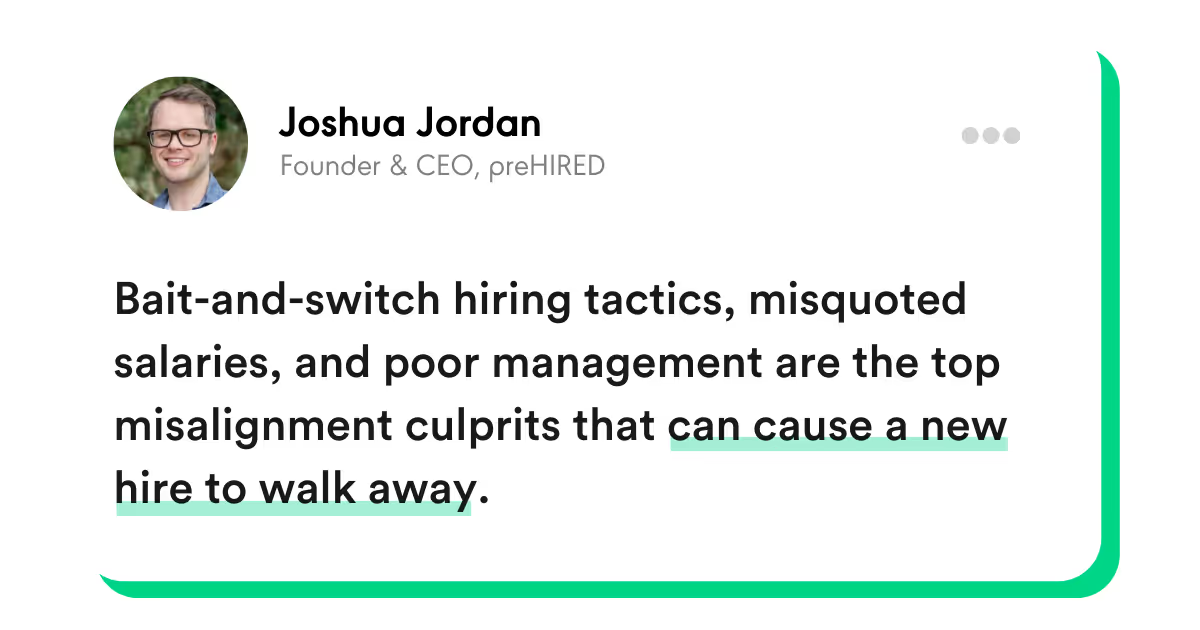Ready to create more pipeline?
Get a demo and discover why thousands of SDR and Sales teams trust LeadIQ to help them build pipeline confidently.





Get a demo and discover why thousands of SDR and Sales teams trust LeadIQ to help them build pipeline confidently.
Ever since the pandemic pushed the majority of the workforce to operate remotely, companies hiring for sales roles have faced a problem: namely, a shortage of people who want to work for them. This lack of applicants has resulted in a persistent shortage of SDRs, causing many to question what their organization is doing wrong.
In order to help understand this dilemma, LeadIQ’s Ryan O’Hara hosted a “Fixing Broken Sales Hiring Practices” webinar and brought two experts on board: Joshua Jordan, Founder and CEO at preHired; and Lori Richardson, Founder and CEO at Score More Sales.
Here are the highlights from their discussion, which explores broken hiring practices and shares tips on how both candidates and companies looking to hire can stand out from the crowd.
To kick off the discussion on the dearth of hiring talent, Joshua shared his background-driven insights. His company, PreHired, focuses on training people to get into the tech space through sales. 90% of PreHired’s participants are looking for remote work, says Joshua, leading him to disclose what he sees as an essential (and sometimes overlooked) fact: that from here on out, tech will work remotely.
Companies that recognize this truth and adopt the right hiring culture + strategies will do better than those that don’t.

Lori added that employee turnover at workplaces directly correlates to this type of attention (or lack thereof). Employers that don’t take care of their employees by addressing their wants and needs are almost guaranteed to lose both new hires and mid-level folks.
Joshua observed that at least once a month, his company needs to find a new placement for someone that was recently hired — not because of the employee’s behavior, but the company’s. Bait-and-switch hiring tactics, misquoted salaries, and poor management are the top misalignment culprits that can cause a new hire to walk away.
Experienced managers and accurate job descriptions are two of the top remedies for increasing a company’s chances of attracting and retaining talent.
One of the biggest mistakes companies make when writing sales posts is overlooking the female perspective, says Lori. Posts with male-dominant language (e.g., requesting a “sniper salesperson”) will dissuade women from applying, as will posts dominated by bullet points (which can encourage all-or-nothing thinking).
Companies can make posts more approachable by highlighting the top desired qualities and saying something along the lines of, “If you have some of these skills, we’d love to talk to you.”
During interviews, managers should expect candidates to come prepared with questions about what the company can do for them. Example topics include inquiries about how to hit quota, the background of leadership, and tools available to employees. Companies with supervisors who have a good reputation and actively strive to invest in employees will see better success than those with poor leadership and little interest in coaching new hires.

Three to six months is a normal amount of time for on-ramping a new hire, says Lori, with plenty of feedback along the way on KPIs. Make sure to deliver on promises made during the interview, and work to create a strong workplace culture that replaces typical in-person activities (such as water cooler chats) with remote work substitutes (such as scheduled video blitzes).
One of the strongest strategies for fixing broken hiring practices is to incorporate personalization. Employers can personalize the hiring experience by assessing if someone is motivated by extrinsic qualities (such as incentives, bonuses, and salary) or by intrinsic qualities, which are aligned with working to make a difference by contributing to something a person believes in. Understanding what people are looking for—and what type of people you’re looking for — can make a huge difference in hiring practices. For instance, if companies replace boilerplate outreaches with thoughtful, personalized ones, the odds of a successful match between the candidate and employer are much higher.
When it comes to creating a successful sales culture, Joshua cites the golden rule: treat others as you would like to be treated. While sales is about serving others, SDRs will eventually get back what they give if they are properly coached and nurtured. An honest relationship between employees and companies can occur when managers keep in mind the value of authenticity and having people’s best interests at heart. Lori adds knowing the “why” of your business is critical to attracting and retaining talent that fits well with your company. Be particular about who you bring on board, and invest in their professional development.
To close out the webinar, the participants shared these final takeaways for job-seekers.
SDRs should always make sure to proofread their resumes, and network as much as possible when seeking new employment. They should also strive to talk about their accomplishments as much as (if not more) than they talk about tasks performed on the job. Including information about career successes — such as how many accounts were managed in a CRM or how much money was brought in each month — can help ensure SDRs don’t undersell themselves, while also giving employers a clear understanding of capabilities.